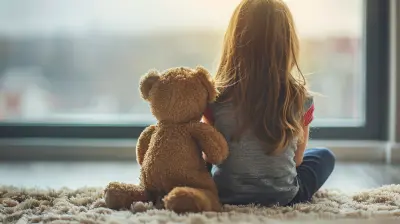The Importance of Safe Spaces for Emotional Healing
14 November 2025
Have you ever felt the weight of the world on your shoulders, with nowhere to turn? Imagine carrying an invisible burden—one that's heavy, suffocating, and relentless. Now, picture a place where you can finally set it down, breathe, and just be yourself. That, my friend, is the power of a safe space.
In a world that often demands we keep our emotions in check, safe spaces offer a sanctuary for emotional healing. But why do they matter so much? And how do they help us heal from the wounds we don’t always see? Let’s dive deep into the mystery behind emotional safe spaces and why they are crucial for our well-being.

What Exactly Is a Safe Space?
A safe space is more than just a physical location—it’s a feeling, a mindset, and an atmosphere where judgment, criticism, and negativity don’t exist. It’s where you can be vulnerable without fear. Whether it's a quiet room, the comforting presence of a close friend, or even an online community, a safe space is anywhere you feel secure enough to express your true emotions without hesitation.But here’s the thing—safe spaces aren’t just about comfort. They’re about healing. Emotional wounds don’t just disappear; they need care, time, and the right environment to mend.

Why Emotional Healing Needs a Safe Space
Think about a deep emotional wound like a physical injury. If you scrape your knee, what do you do? You clean it, cover it, and give it time to heal. Now, imagine trying to heal while constantly rubbing dirt into it. Impossible, right? That’s exactly what happens when we lack a safe space for emotional recovery.When we go through trauma, stress, or heartbreak, we need a protected environment to process those emotions. Without it, we either suppress our feelings or let them fester into something worse—anxiety, depression, or emotional numbness.
1. A Safe Space Grants Permission to Feel
Society often tells us to "toughen up" or “move on” too quickly. But healing doesn’t work like that. You can’t rush it. Safe spaces allow you to sit with your emotions without pressure—to cry, to vent, or to simply exist without judgment.2. It Encourages Self-Reflection
Healing isn’t just about feeling—it’s about understanding. Safe spaces give you the breathing room to reflect on your emotions, recognize patterns in your behavior, and gain a deeper sense of self-awareness.3. It Lowers Stress and Anxiety
When you're constantly in fight-or-flight mode, your body and mind never really relax. Emotional safe spaces act like a reset button, calming your nervous system and allowing you to regain emotional balance.4. Strengthens Emotional Resilience
Ever notice how some people seem to bounce back from hardships faster than others? It’s not magic—it’s emotional resilience. Having a trusted space where you can process pain makes you stronger over time, teaching you how to handle future challenges with greater ease.
What Makes a Space Truly Safe?
Not all spaces that claim to be "safe" actually are. A true safe space is built on trust, respect, and genuine support.1. Non-Judgmental Atmosphere
A safe space is where you can express yourself without fear of being criticized, mocked, or dismissed. There’s no room for shame—only acceptance.2. Confidentiality and Trust
Whether it’s with a friend, therapist, or support group, a safe space must protect your privacy. Trust is the foundation, and once it's broken, the space is no longer truly safe.3. Emotional Validation
Sometimes, we just need someone to say, "I hear you. Your feelings are valid." A safe space doesn’t try to fix you; it acknowledges you.4. Encouragement of Healthy Expression
In a safe space, you’re allowed to express yourself in whatever way helps you heal—writing, talking, crying, or even sitting in silence. There’s no “right” way to process emotions.
The Role of Safe Spaces in Mental Health
Mental health professionals widely recognize the importance of safe spaces in therapy and counseling. But beyond professional help, safe spaces play a role in everyday life as well. They can be found in:- Friendships and family bonds – A close friend or relative who listens without judgment can be a powerful safe space.
- Support groups and communities – Whether online or in person, these groups provide understanding and encouragement.
- Personal sanctuaries – A quiet place at home, a favorite coffee shop, or even journaling in solitude can serve as a private safe space for reflection.
How to Create a Safe Space for Yourself and Others
1. Set Boundaries
Creating a safe space starts with boundaries. Choose who you allow into your emotional world carefully and make sure they respect your need for support rather than offering unsolicited advice or judgment.2. Find the Right People
Not everyone deserves access to your vulnerability. Surround yourself with individuals who uplift and support you rather than those who drain you emotionally.3. Be a Safe Space for Others
If you want safe spaces to exist, you must also offer that same refuge to others. Listen without judgment, respect privacy, and validate emotions without dismissing them.4. Create a Physical Safe Space
Have a designated place where you feel at peace. Whether it’s a cozy reading nook, a meditation corner, or a spot in nature, having a go-to escape can make a world of difference.
The Transformational Power of Safe Spaces
Imagine carrying a heavy backpack for years, feeling its weight pressing down on you every moment of every day. Now, imagine stepping into a room where you can finally set it down. Relief washes over you. That’s what a safe space does for the soul.Safe spaces aren’t just about escaping reality or seeking comfort—they’re about healing, rebuilding, and growing into a stronger version of yourself. They allow you to confront pain in a controlled environment, process emotions in a healthy way, and emerge on the other side with a newfound sense of clarity and resilience.
So, the next time you feel overwhelmed, ask yourself—do you have a safe space to retreat to? If not, it might be time to create one. You deserve to heal, to feel, and to be seen. Because at the end of the day, a safe space isn’t a luxury—it’s a necessity for emotional well-being.
all images in this post were generated using AI tools
Category:
Emotional HealingAuthor:

Eliana Burton
Discussion
rate this article
1 comments
Theodore Reynolds
Creating safe spaces is vital for emotional healing. They allow individuals to express their feelings without judgment, fostering connection and understanding. By nurturing these environments, we can support one another’s journeys toward healing and resilience in a compassionate way.
November 14, 2025 at 4:39 AM


